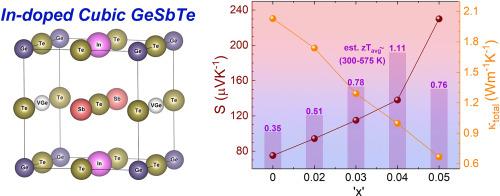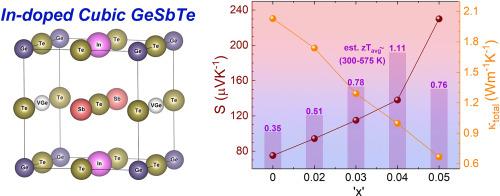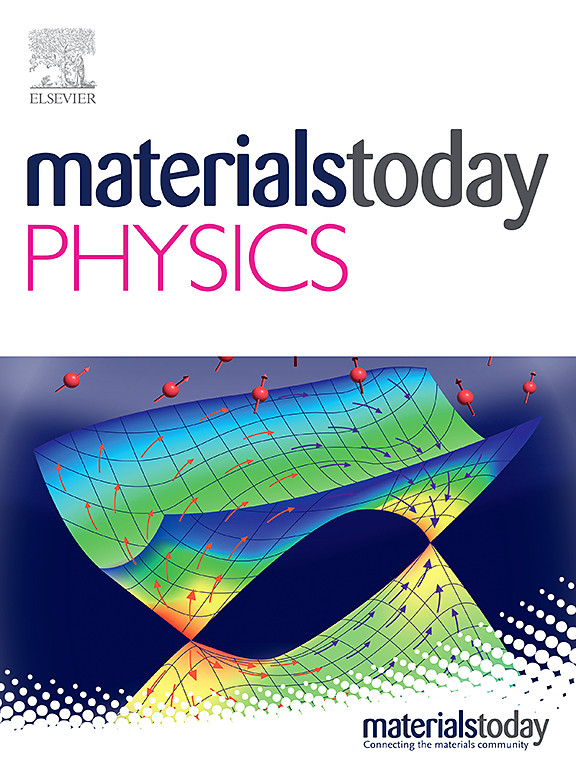掺杂铟对立方 GeTe 基薄膜热电性能的协同效应
IF 10
2区 材料科学
Q1 MATERIALS SCIENCE, MULTIDISCIPLINARY
引用次数: 0
摘要
碲化镉锗(GeTe)的斜方体相和立方体相作为一种前景广阔的无铅热电材料已被广泛探索。然而,这两种相在 ∼700 K 时的结构转变会导致热膨胀系数的突然变化,这对其更广泛的实际应用提出了挑战。此外,高温立方相具有多价带和强非谐相互作用的特点,与斜方体相相比,其功率因数更高,热导率更低,热电性能更优。有鉴于此,在这项工作中,通过射频溅射和退火后处理,成功实现了 Ge0.9Sb0.1Te(下文中称为 GeSbTe)纳米晶薄膜的立方相。此外,铟作为锗位点的电子供体和有效的散射中心,进一步缓和了载流子浓度,提高了塞贝克系数并降低了热导率。在 300 K 至 575 K 的温度范围内,最佳成分的峰值估计为 ∼ 1.95,平均值估计为 ∼ 1.11,这表明 GeTe 是接近室温应用的理想候选材料。本文章由计算机程序翻译,如有差异,请以英文原文为准。


Synergistic effect of indium doping on thermoelectric performance of cubic GeTe-based thin films
Germanium Telluride (GeTe) has been widely explored as a promising lead-free thermoelectric material in its rhombohedral and cubic phases. However, the structural transition between these two phases at ∼700 K causes an abrupt change of thermal expansion coefficient, challenging its broader practical applications. Also, as characterized by multi-valence bands and strong anharmonic interaction, the high-temperature cubic phase exhibits a higher power factor, lower thermal conductivity, and ultimately superior thermoelectric performance than its rhombohedral counterpart. Prompted by these, in this work, the cubic phase of Ge0.9Sb0.1Te (presented as GeSbTe in the following content) nanocrystalline thin film is successfully realized by RF sputtering followed by post-annealing treatment. Additionally, indium, as an electron donor to the germanium site and an effective scattering center, further moderates carrier concentration, enhances the Seebeck coefficient and reduces thermal conductivity. The optimal composition achieves an estimated peak of ∼1.95 and an estimated average of ∼1.11 within the temperature range of 300 K–575 K, showcasing GeTe as a compelling candidate for applications close to room temperature.
求助全文
通过发布文献求助,成功后即可免费获取论文全文。
去求助
来源期刊

Materials Today Physics
Materials Science-General Materials Science
CiteScore
14.00
自引率
7.80%
发文量
284
审稿时长
15 days
期刊介绍:
Materials Today Physics is a multi-disciplinary journal focused on the physics of materials, encompassing both the physical properties and materials synthesis. Operating at the interface of physics and materials science, this journal covers one of the largest and most dynamic fields within physical science. The forefront research in materials physics is driving advancements in new materials, uncovering new physics, and fostering novel applications at an unprecedented pace.
 求助内容:
求助内容: 应助结果提醒方式:
应助结果提醒方式:


